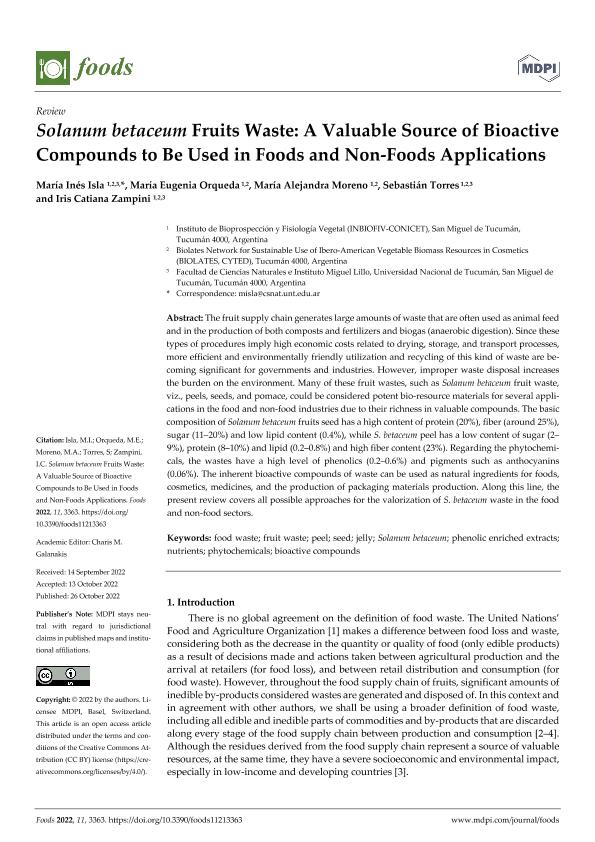Artículo
Solanum betaceum Fruits Waste: A Valuable Source of Bioactive Compounds to Be Used in Foods and Non-Foods Applications
Isla, Maria Ines ; Orqueda, Maria Eugenia
; Orqueda, Maria Eugenia ; Moreno, María Alejandra
; Moreno, María Alejandra ; Torres, Sebastián
; Torres, Sebastián ; Zampini, Iris Catiana
; Zampini, Iris Catiana
 ; Orqueda, Maria Eugenia
; Orqueda, Maria Eugenia ; Moreno, María Alejandra
; Moreno, María Alejandra ; Torres, Sebastián
; Torres, Sebastián ; Zampini, Iris Catiana
; Zampini, Iris Catiana
Fecha de publicación:
10/2022
Editorial:
MDPI
Revista:
Foods
ISSN:
2304-8158
Idioma:
Inglés
Tipo de recurso:
Artículo publicado
Clasificación temática:
Resumen
The fruit supply chain generates large amounts of waste that are often used as animal feed and in the production of both composts and fertilizers and biogas (anaerobic digestion). Since these types of procedures imply high economic costs related to drying, storage, and transport processes, more efficient and environmentally friendly utilization and recycling of this kind of waste are becoming significant for governments and industries. However, improper waste disposal increases the burden on the environment. Many of these fruit wastes, such as Solanum betaceum fruit waste, viz., peels, seeds, and pomace, could be considered potent bio-resource materials for several applications in the food and non-food industries due to their richness in valuable compounds. The basic composition of Solanum betaceum fruits seed has a high content of protein (20%), fiber (around 25%), sugar (11–20%) and low lipid content (0.4%), while S. betaceum peel has a low content of sugar (2–9%), protein (8–10%) and lipid (0.2–0.8%) and high fiber content (23%). Regarding the phytochemicals, the wastes have a high level of phenolics (0.2–0.6%) and pigments such as anthocyanins (0.06%). The inherent bioactive compounds of waste can be used as natural ingredients for foods, cosmetics, medicines, and the production of packaging materials production. Along this line, the present review covers all possible approaches for the valorization of S. betaceum waste in the food and non-food sectors.
Archivos asociados
Licencia
Identificadores
Colecciones
Citación
Isla, Maria Ines; Orqueda, Maria Eugenia; Moreno, María Alejandra; Torres, Sebastián; Zampini, Iris Catiana; Solanum betaceum Fruits Waste: A Valuable Source of Bioactive Compounds to Be Used in Foods and Non-Foods Applications; MDPI; Foods; 11; 21; 10-2022; 1-18
Compartir
Altmétricas



